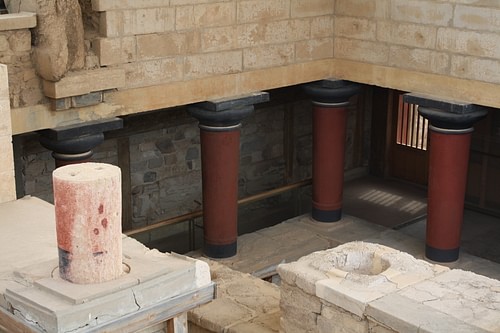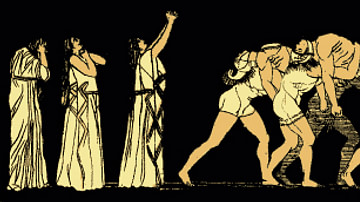
Daedalus is a figure from Greek mythology famous for his sculptures, clever inventions, and as the architect of the Minotaur's labyrinth on Crete. Daedalus is the father of Icarus who flew too close to the Sun on his artificial wings and so drowned in the Mediterranean.
By the Roman period, Daedalus had acquired a long string of accomplishments and he came to represent the general idea of the supreme master craftsman. The myths of Daedalus appear in the works of such noted writers as Homer, Herodotus, Ovid, and Virgil.
Origins & Name
The ancient Greeks closely associated Daedalus (also spelt Daidalos) with the god Hephaistos, the genius craftsman of Mt. Olympus. It is possible that both figures have their origin in the Phoenician and Ugarit god Kothar, who was also considered a skilled artisan. In addition, it seems likely that highly valued artworks traded by the Phoenicians and reaching Greece, especially Crete, gave rise to myths concerning the fabled craftsmen of the Near East. Moreover, the very word daidalos signified 'finely-worked' and 'elaborate'.
Craftsman to King Minos
In Book 18 of the Iliad, Homer mentions that Daedalus lived at Knossos on Crete and designed an open-air dance floor there for King Minos' daughter Ariadne. He is credited in later sources as offering his considerable skills for other projects on Crete, specifically, designing the wooden bull that Minos' wife Pasiphae used to capture the affections of the bull she was in love with, building Minos' palace, and constructing the labyrinth where the offspring of that union, the half man-half bull Minotaur, dwelt. The same sources also report that Daedalus made the thread which Ariadne gave to the hero Theseus so that he might kill the Minotaur and escape from the labyrinth.
Daedalus & Icarus Flee Crete
Daedalus fell out of favour with King Minos, probably, and perhaps understandably, for the cow he had built Pasiphae, and he and his son Icarus were forced to flee for their lives. For this purpose, Daedalus constructed wings so that the pair might fly with ease from the wrathful king. Daedalus warned his son that for the wings to function best he should not fly too close to the sea lest the moisture render the feathers too heavy and useless, nor should he fly too high or the sun's heat would likewise damage the wings.
The young Icarus, alas, did not heed his father's advice and, on over-reaching himself and flying too close to the sun, the heat melted the wax which attached the wings to his arms. As a consequence, he plummeted into the sea and drowned in a tale that reminded of the folly of over-ambition. The tragedy was commemorated in the naming of the stretch of waters in that area the Icarian Sea, and then, when Hercules dragged the washed up body to an island, he re-named that place Icaria in honour of the fallen youth. The island still bears the name today and lies just south-west of Samos.
Daedalus on Sicily
Meanwhile, Daedalus had made it safely to Sicily where he was looked after by King Cocalus (also spelt Kokalos). In gratitude to Hercules, Daedalus sculpted a fantastically life-like statue of the hero. Unfortunately, this statue came to an unfortunate end one night, when Hercules himself stumbled across it and, convinced by its realism, thought it an enemy and smashed it to pieces. At the same time, King Minos had not simply allowed his talented architect to escape scot-free and actually pursued him all the way to Sicily but upon landing the daughters of Cocalus boiled him alive in a steam bath. Daedalus soon gave Cocalus reason to be glad for his arrival as he continued to produce such masterworks as a golden ram (or honeycomb) for the temple of Aphrodite on Mt. Eryx, a fortress at Acragas (Agrigento), and a steam bath at Selinus (Selinunte).
The Legend of Daedalus Grows
From the 5th century BCE, Athens claimed the artist as one of their own, and Theseus was considered to have brought him back to Athens, replacing Crete as his place of birth and Sicily as his final destination. A whole family tree was devised so that such figures as Socrates claimed descent from Daedalus. The craftsman was given a nephew, Talos, the man of bronze who protected Crete, whom he killed, jealous of the younger man's invention of the saw, compass, and potter's wheel. This murder explained why Daedalus was exiled to Crete. Over the following centuries, Daedalus was credited with an ever-increasing number of fabulous inventions and artworks, from living statues to the magnificently decorated golden doors of the temple of Apollo at Cumae, Italy. He was even said to have invented the walking pose of early Greek statues, differentiating them from earlier and somewhat static Egyptian figures and paving the way for the more life-like poses of later Greek sculpture. The Romans even made Daedalus the patron of carpenters.
How is Daedalus Represented in Art?
Daedalus and Icarus appear in Greek art, especially pottery painting. The earliest Greek example may date to c. 560 BCE. The pair also appear on an Etruscan gold amulet (bulla) from c. 470 BCE. Daedalus' labyrinth was used as a symbol on Cretan coins and was a popular motif for Roman mosaic makers. In Greek drama, Daedalus was the subject of several satyr plays and comedies, including those by such notable playwrights as Sophocles and Aristophanes. The Roman writer Ovid gave the figure a new lease of life in the Roman era by describing Daedalus' adventures in his Metamorphosis (Bk. 8). Consequently, he became a favourite subject of Roman painters, notably seen in a 1st-century CE wall painting of the House of the Vettii at Pompeii. Even in the modern world Daedalus' name lives on as a style of Archaic sculpture (Daedalic) which demonstrates the orientalizing features seen in early Greek sculpture.







